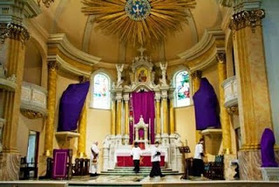
In some places the crosses were covered on Ash Wednesday; in others on the first Sunday of Lent. In England it was customary on the first Monday of Lent to cover up all the crucifixes, images of every kind, the reliquaries, and even the cup with the Blessed Sacrament. The cloths used were of white linen or silk and marked with a red cross (Rock, infra, IV, 258). The two beautiful hymns of the season, "Vexilla Regis" and "Pange lingua gloriosi", are the work of Venantius Fortunatus, Bishop of Poitiers. On the Friday of Passion Week the Church very appropriately honours the Seven Dolours of Our Lady. On Saturday the Greeks commemorate the resuscitation of Lazarus.





